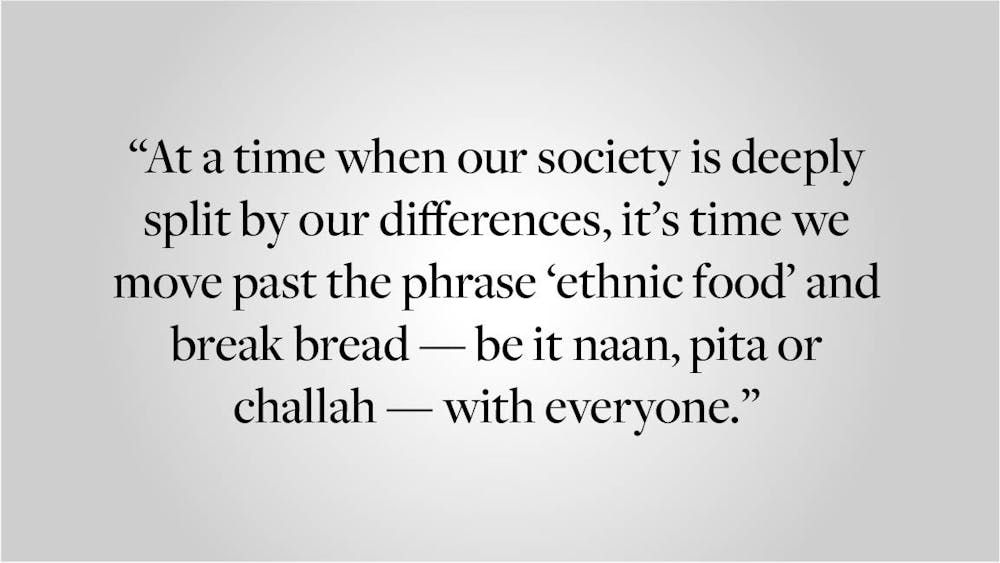With Thayer Street a one-minute walk from my dorm, I’ve often found myself browsing Yelp for food options. I love the category search function in particular, which allows users to browse for food options by cuisine. One category I’ve noticed is “ethnic” restaurants. The word “ethnic” could be referring to exotic cultural dishes and challenging flavors that are certainly different from mainstream Western cuisine. The adjective isn’t exclusive to Yelp, either. It can be found on the webpages of Spoon University, Better Homes and Gardens and Rhode Island Monthly. But the word “ethnic” raises an important question: Ethnic as opposed to what?
The problem with the phrase “ethnic food” is that it implies the existence of some kind of normative, white American cuisine. When we categorize different foods into “ethnic” and American, what does that say about how we view other races and cultures in America? Why are waffles from Belgium and pizza from Italy considered American food while foods from Iran or Vietnam are othered as “ethnic?” At a time when our society is deeply split by our differences, it’s time we move past the phrase “ethnic food” and break bread — be it naan, pita or challah — with everyone.
The Merriam-Webster Dictionary defines the adjective “ethnic” as “of or relating to large groups of people classed according to common racial, national, tribal, religious, linguistic or cultural origin or background.” By this definition, all food is ethnic. Yale culinary historian Paul Freedman details the racist and classist stereotypes that are implied by the term “ethnic food” in his essay, “There is No Such Thing as a Nonethnic Restaurant,” published in the book “You and I Eat the Same.” The term “ethnic food” is connected to America’s history of immigration. Food made by immigrants in the 19th and 20th centuries was often seen as unhealthy or suspect. But these cuisines were also slowly accepted by the American public. For example, Chinese food was embraced in New York City in the early 20th century due to its cheapness, especially by bohemians. That association of immigrant communities’ foods with cheapness led to otherization that persists today.
Academic research seems to support this conclusion. According to a study done by Krishnendu Ray, professor of food studies at New York University, Americans have been willing to spend more on French food compared to most other cuisines and expect to spend less on Chinese, Vietnamese and Thai dishes. Ray argued to Quartz that the price we place on food is reflective of cultural prestige. According to his logic, the price we pay for food is tied to perceptions of racial and ethnic groups.
For example, searching the “top 10 best ethnic restaurants in Providence, RI” on Yelp yields diverse cuisines such as Caribbean, Turkish, Peruvian, Mexican, Thai and Syrian. Most restaurants are labeled with one or two dollar signs, a symbol that indicates the relatively low price of a typical meal. On the other hand, searching the “top 10 best American restaurants in Providence, RI” reveals food that carries Italian, German and French origins, such as hamburgers and pizza. More restaurants in the list have three or four dollar signs. This is not only indicative of the lower-price phenomenon associated with ethnic food but also the racial divide in which cuisines are deemed American and which are “ethnic.”
The phrase “ethnic food” and the stereotypes associated with it are no longer socially acceptable. That’s not to say that using the word “ethnic” is inherently racist, but the language we use is a powerful tool in shaping our attitudes toward other people. When someone refers to non-white cuisine as “ethnic food,” they are upholding an idea that Western European cuisine, and therefore Western European people, are not ethnic while grouping all non-white cuisines, cultures and people into one amorphous blob. The expectation of automatically lower prices for cultural foods such as tacos and dumplings also devalues those who cook the food and their culinary heritage.
We won’t become racial pioneers if we stop using the phrase “ethnic food.” But some actionable things to do include learning about the pronunciation of dishes, researching the history of foods and specifying the cultural cuisine instead of using the blanket phrase “ethnic food.” Though these actions may seem trivial, they are meaningful steps we should take to better foster cultural literacy.
There is no difference between ethnic and non-ethnic food. American cuisine, like its people, is an eclectic mix of borrowed cultures, traditions and flavors that have adapted to the people who have immigrated here and call this place home. After all, even the phrase “American as apple pie” refers to a dessert that comes from England. Sorry, Johnny Appleseed.
Juliet Fang ’26 can be reached at juliet_fang@brown.edu. Please send responses to this opinion to letters@browndailyherald.com and other op-eds to opinions@browndailyherald.com.
Juliet Fang is a second year at Brown studying Ecology and Evolutionary Biology. In her free time, she enjoys running, cycling, and watching duck videos.





